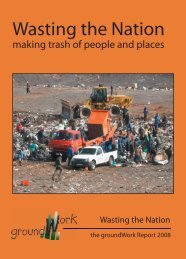Incinerators in Disguise - GAIA
Incinerators in Disguise - GAIA
Incinerators in Disguise - GAIA
Create successful ePaper yourself
Turn your PDF publications into a flip-book with our unique Google optimized e-Paper software.
<strong>Inc<strong>in</strong>erators</strong> In <strong>Disguise</strong>: Case Studies 4<br />
The <strong>in</strong>dustry and its allies are push<strong>in</strong>g legislation <strong>in</strong> California to encourage the sit<strong>in</strong>g and f<strong>in</strong>anc<strong>in</strong>g<br />
of facilities. The California Integrated Waste Management Board has made at least one large loan for<br />
a catalytic crack<strong>in</strong>g facility proposed by Plastic Energy LLC for Hanford <strong>in</strong> the San Joaqu<strong>in</strong> Valley<br />
despite the lack of any data to back up the company’s claims of no emissions. The California<br />
Pollution Control F<strong>in</strong>ance Authority is now be<strong>in</strong>g asked by InEnTec for tax-exempt bonds to help<br />
f<strong>in</strong>ance their proposed plasma arc medical waste facility <strong>in</strong> Red Bluff, located <strong>in</strong> Tehama County <strong>in</strong><br />
northern California.<br />
Counties such as Los Angeles and Santa Barbara <strong>in</strong> California are consider<strong>in</strong>g these technologies,<br />
but are rely<strong>in</strong>g heavily on <strong>in</strong>dustry studies. For example, URS Technology released a report <strong>in</strong><br />
September 2005 commissioned by Los Angeles County that ranked Thermoselect gasification<br />
technology as the most promis<strong>in</strong>g of the companies URS considered, a curious model as<br />
Thermoselect’s flagship facility <strong>in</strong> Germany was a failure and closed <strong>in</strong> 2004. The URS report refers<br />
to Interstate Waste Technologies, the U.S. licensee of Thermoselect’s gasification technology.<br />
Add<strong>in</strong>g to the concern of community members and public health advocates is the fact that the<br />
projects seen to date are gett<strong>in</strong>g approved <strong>in</strong> California without Environmental Impact Reports, and<br />
<strong>in</strong> some cases without real public notice or public hear<strong>in</strong>gs. Many government agencies and<br />
regulators on local, state, and national levels are fail<strong>in</strong>g to scrut<strong>in</strong>ize the claims be<strong>in</strong>g made by many<br />
companies, and are quick to approve and support these so-called conversion technologies. In many<br />
cases, the media has repeated the public relations claims of companies without <strong>in</strong>vestigation, only to<br />
f<strong>in</strong>d out later that certa<strong>in</strong> key <strong>in</strong>dustry claims, such as “no emissions,” were not true.<br />
Public Relations Claims Vs. Reality:<br />
Problems with Exist<strong>in</strong>g Facilities<br />
In the United States, there have been only a few companies us<strong>in</strong>g these technologies commercially<br />
for waste treatment, and the operations at the two facilities where <strong>in</strong>formation is available were<br />
plagued with problems. These case studies document the problematic nature of these technologies<br />
on three cont<strong>in</strong>ents.<br />
Allied Technology Group operated a plasma arc facility for mixed radioactive and hazardous wastes<br />
<strong>in</strong> Richland, Wash<strong>in</strong>gton, and the facility closed due to operational problems with the plasma arc<br />
equipment as well as f<strong>in</strong>ancial problems. The Hawaii Medical Vitrification facility run by Asian<br />
Pacific Environmental Technologies near Honolulu has also had serious operational problems as<br />
well as serious permit violations. For example, the Hawaii Medical Vitrification facility was closed<br />
for approximately eight months due to refractory damage <strong>in</strong> the kiln of the plasma arc equipment.<br />
Both the Allied Technology Group and the Hawaii Medical Vitrification facilities used Integrated<br />
Environmental Technologies’ (IET) “Plasma Enhanced Melter” equipment. IET and their related<br />
company InEnTec claimed on their website that these two facilities were successful commercial<br />
operations us<strong>in</strong>g their technology, but the facts show that there were severe problems with the<br />
plasma arc equipment at both facilities.

















